Comparing Effective and Ineffective Teams: A Detailed Report
VerifiedAdded on 2020/11/12
|10
|2911
|307
Report
AI Summary
This report delves into the comparison between effective and ineffective teams, examining key aspects of organizational behavior. It explores various types of teams, including department, problem-solving, virtual, cross-functional, and self-managed teams, along with their respective hard and soft skills based on the emotional intelligence framework. The report highlights the importance of effective teams for organizational success, discussing team development theories like Tuckman's stages and Belbin's team role model. Belbin's model, in particular, is analyzed, outlining the nine roles essential for team effectiveness. Furthermore, the report touches upon team performance and the application of Belbin's theory. It also covers fundamental concepts of organizational behavior, such as individual behavior, perception, the whole person, motivated behavior, the desire for involvement, and the value of the person, providing a comprehensive overview of team dynamics and organizational principles.
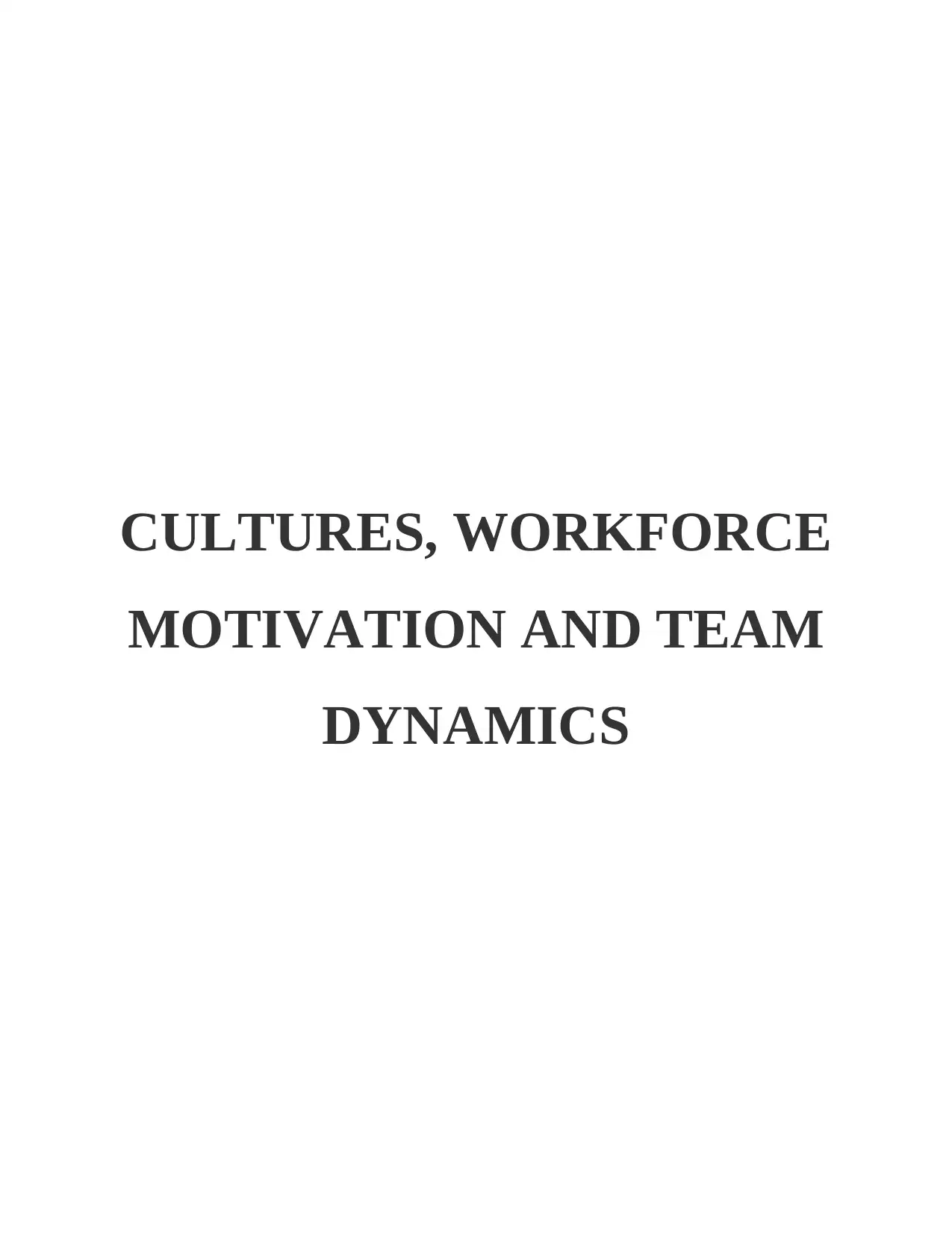
CULTURES, WORKFORCE
MOTIVATION AND TEAM
DYNAMICS
MOTIVATION AND TEAM
DYNAMICS
Paraphrase This Document
Need a fresh take? Get an instant paraphrase of this document with our AI Paraphraser
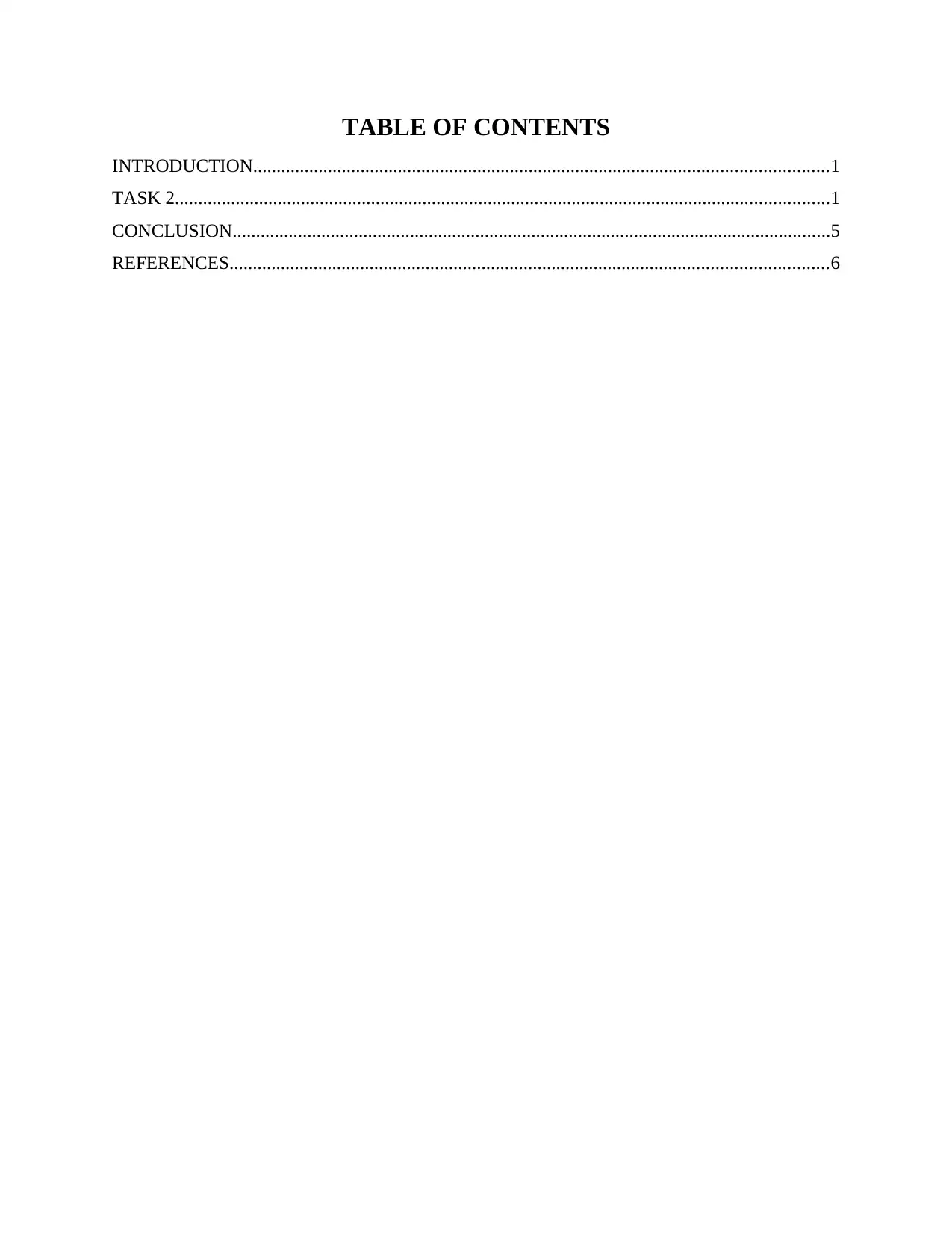
TABLE OF CONTENTS
INTRODUCTION...........................................................................................................................1
TASK 2............................................................................................................................................1
CONCLUSION................................................................................................................................5
REFERENCES................................................................................................................................6
INTRODUCTION...........................................................................................................................1
TASK 2............................................................................................................................................1
CONCLUSION................................................................................................................................5
REFERENCES................................................................................................................................6
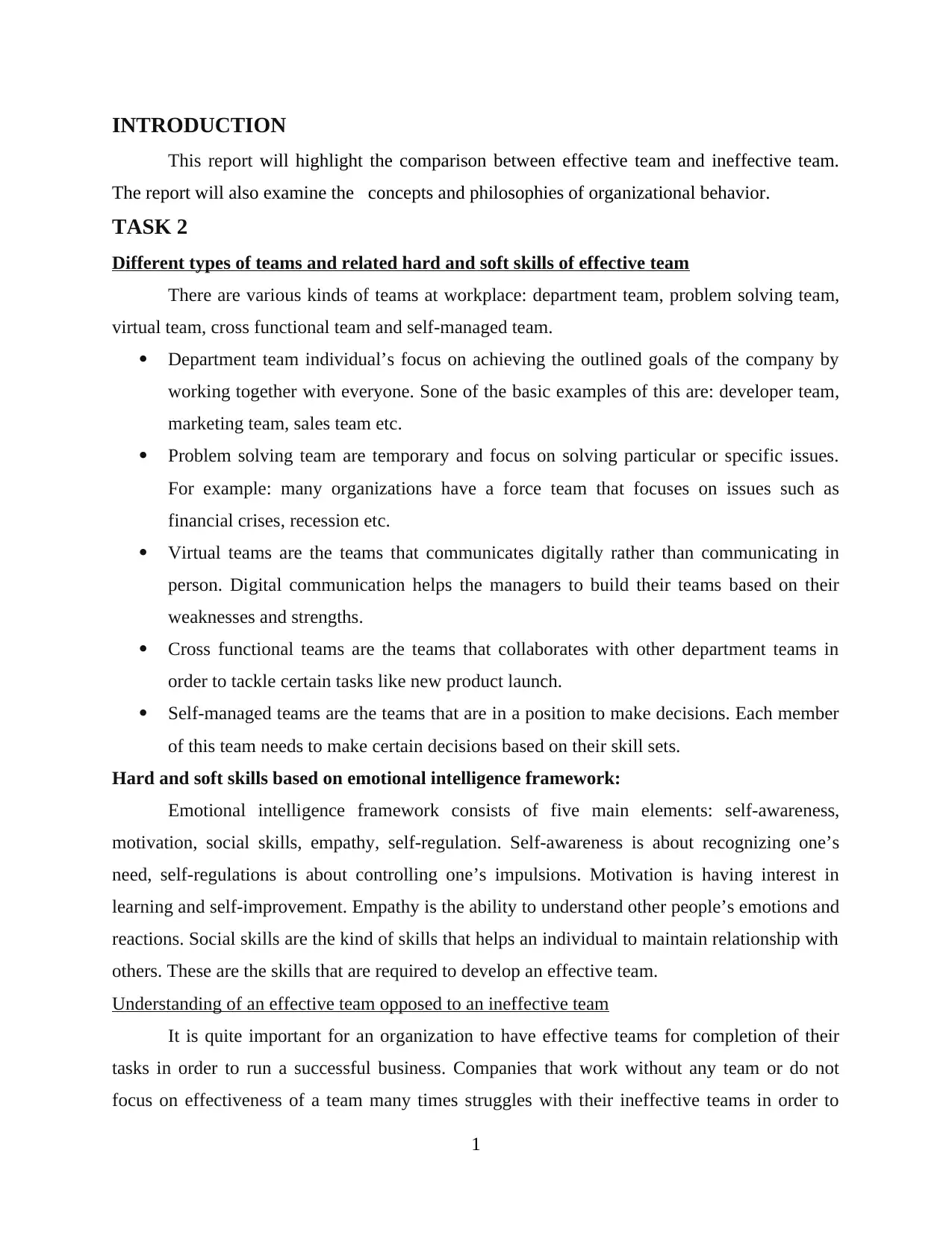
INTRODUCTION
This report will highlight the comparison between effective team and ineffective team.
The report will also examine the concepts and philosophies of organizational behavior.
TASK 2
Different types of teams and related hard and soft skills of effective team
There are various kinds of teams at workplace: department team, problem solving team,
virtual team, cross functional team and self-managed team.
Department team individual’s focus on achieving the outlined goals of the company by
working together with everyone. Sone of the basic examples of this are: developer team,
marketing team, sales team etc.
Problem solving team are temporary and focus on solving particular or specific issues.
For example: many organizations have a force team that focuses on issues such as
financial crises, recession etc.
Virtual teams are the teams that communicates digitally rather than communicating in
person. Digital communication helps the managers to build their teams based on their
weaknesses and strengths.
Cross functional teams are the teams that collaborates with other department teams in
order to tackle certain tasks like new product launch.
Self-managed teams are the teams that are in a position to make decisions. Each member
of this team needs to make certain decisions based on their skill sets.
Hard and soft skills based on emotional intelligence framework:
Emotional intelligence framework consists of five main elements: self-awareness,
motivation, social skills, empathy, self-regulation. Self-awareness is about recognizing one’s
need, self-regulations is about controlling one’s impulsions. Motivation is having interest in
learning and self-improvement. Empathy is the ability to understand other people’s emotions and
reactions. Social skills are the kind of skills that helps an individual to maintain relationship with
others. These are the skills that are required to develop an effective team.
Understanding of an effective team opposed to an ineffective team
It is quite important for an organization to have effective teams for completion of their
tasks in order to run a successful business. Companies that work without any team or do not
focus on effectiveness of a team many times struggles with their ineffective teams in order to
1
This report will highlight the comparison between effective team and ineffective team.
The report will also examine the concepts and philosophies of organizational behavior.
TASK 2
Different types of teams and related hard and soft skills of effective team
There are various kinds of teams at workplace: department team, problem solving team,
virtual team, cross functional team and self-managed team.
Department team individual’s focus on achieving the outlined goals of the company by
working together with everyone. Sone of the basic examples of this are: developer team,
marketing team, sales team etc.
Problem solving team are temporary and focus on solving particular or specific issues.
For example: many organizations have a force team that focuses on issues such as
financial crises, recession etc.
Virtual teams are the teams that communicates digitally rather than communicating in
person. Digital communication helps the managers to build their teams based on their
weaknesses and strengths.
Cross functional teams are the teams that collaborates with other department teams in
order to tackle certain tasks like new product launch.
Self-managed teams are the teams that are in a position to make decisions. Each member
of this team needs to make certain decisions based on their skill sets.
Hard and soft skills based on emotional intelligence framework:
Emotional intelligence framework consists of five main elements: self-awareness,
motivation, social skills, empathy, self-regulation. Self-awareness is about recognizing one’s
need, self-regulations is about controlling one’s impulsions. Motivation is having interest in
learning and self-improvement. Empathy is the ability to understand other people’s emotions and
reactions. Social skills are the kind of skills that helps an individual to maintain relationship with
others. These are the skills that are required to develop an effective team.
Understanding of an effective team opposed to an ineffective team
It is quite important for an organization to have effective teams for completion of their
tasks in order to run a successful business. Companies that work without any team or do not
focus on effectiveness of a team many times struggles with their ineffective teams in order to
1
⊘ This is a preview!⊘
Do you want full access?
Subscribe today to unlock all pages.

Trusted by 1+ million students worldwide
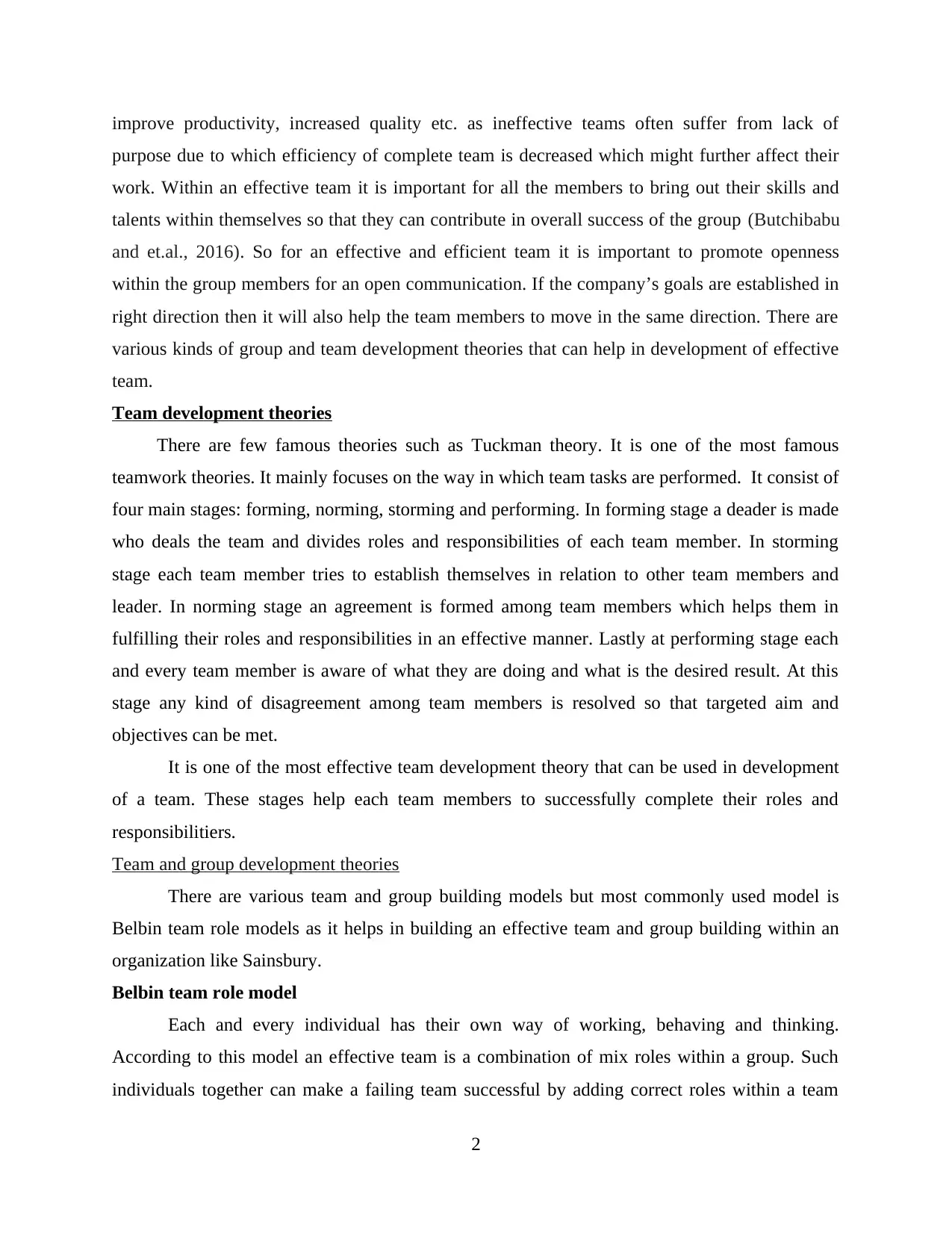
improve productivity, increased quality etc. as ineffective teams often suffer from lack of
purpose due to which efficiency of complete team is decreased which might further affect their
work. Within an effective team it is important for all the members to bring out their skills and
talents within themselves so that they can contribute in overall success of the group (Butchibabu
and et.al., 2016). So for an effective and efficient team it is important to promote openness
within the group members for an open communication. If the company’s goals are established in
right direction then it will also help the team members to move in the same direction. There are
various kinds of group and team development theories that can help in development of effective
team.
Team development theories
There are few famous theories such as Tuckman theory. It is one of the most famous
teamwork theories. It mainly focuses on the way in which team tasks are performed. It consist of
four main stages: forming, norming, storming and performing. In forming stage a deader is made
who deals the team and divides roles and responsibilities of each team member. In storming
stage each team member tries to establish themselves in relation to other team members and
leader. In norming stage an agreement is formed among team members which helps them in
fulfilling their roles and responsibilities in an effective manner. Lastly at performing stage each
and every team member is aware of what they are doing and what is the desired result. At this
stage any kind of disagreement among team members is resolved so that targeted aim and
objectives can be met.
It is one of the most effective team development theory that can be used in development
of a team. These stages help each team members to successfully complete their roles and
responsibilitiers.
Team and group development theories
There are various team and group building models but most commonly used model is
Belbin team role models as it helps in building an effective team and group building within an
organization like Sainsbury.
Belbin team role model
Each and every individual has their own way of working, behaving and thinking.
According to this model an effective team is a combination of mix roles within a group. Such
individuals together can make a failing team successful by adding correct roles within a team
2
purpose due to which efficiency of complete team is decreased which might further affect their
work. Within an effective team it is important for all the members to bring out their skills and
talents within themselves so that they can contribute in overall success of the group (Butchibabu
and et.al., 2016). So for an effective and efficient team it is important to promote openness
within the group members for an open communication. If the company’s goals are established in
right direction then it will also help the team members to move in the same direction. There are
various kinds of group and team development theories that can help in development of effective
team.
Team development theories
There are few famous theories such as Tuckman theory. It is one of the most famous
teamwork theories. It mainly focuses on the way in which team tasks are performed. It consist of
four main stages: forming, norming, storming and performing. In forming stage a deader is made
who deals the team and divides roles and responsibilities of each team member. In storming
stage each team member tries to establish themselves in relation to other team members and
leader. In norming stage an agreement is formed among team members which helps them in
fulfilling their roles and responsibilities in an effective manner. Lastly at performing stage each
and every team member is aware of what they are doing and what is the desired result. At this
stage any kind of disagreement among team members is resolved so that targeted aim and
objectives can be met.
It is one of the most effective team development theory that can be used in development
of a team. These stages help each team members to successfully complete their roles and
responsibilitiers.
Team and group development theories
There are various team and group building models but most commonly used model is
Belbin team role models as it helps in building an effective team and group building within an
organization like Sainsbury.
Belbin team role model
Each and every individual has their own way of working, behaving and thinking.
According to this model an effective team is a combination of mix roles within a group. Such
individuals together can make a failing team successful by adding correct roles within a team
2
Paraphrase This Document
Need a fresh take? Get an instant paraphrase of this document with our AI Paraphraser
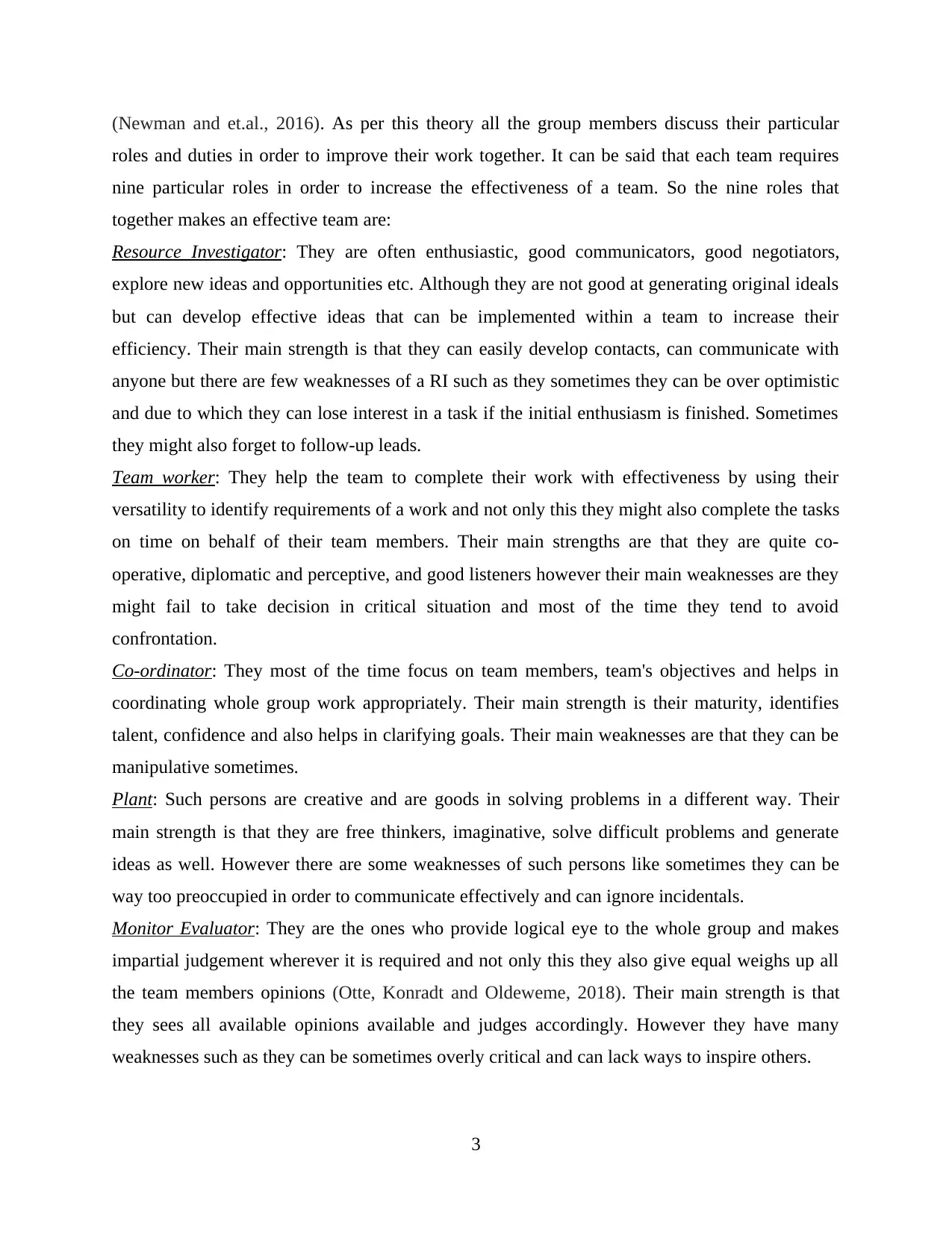
(Newman and et.al., 2016). As per this theory all the group members discuss their particular
roles and duties in order to improve their work together. It can be said that each team requires
nine particular roles in order to increase the effectiveness of a team. So the nine roles that
together makes an effective team are:
Resource Investigator: They are often enthusiastic, good communicators, good negotiators,
explore new ideas and opportunities etc. Although they are not good at generating original ideals
but can develop effective ideas that can be implemented within a team to increase their
efficiency. Their main strength is that they can easily develop contacts, can communicate with
anyone but there are few weaknesses of a RI such as they sometimes they can be over optimistic
and due to which they can lose interest in a task if the initial enthusiasm is finished. Sometimes
they might also forget to follow-up leads.
Team worker: They help the team to complete their work with effectiveness by using their
versatility to identify requirements of a work and not only this they might also complete the tasks
on time on behalf of their team members. Their main strengths are that they are quite co-
operative, diplomatic and perceptive, and good listeners however their main weaknesses are they
might fail to take decision in critical situation and most of the time they tend to avoid
confrontation.
Co-ordinator: They most of the time focus on team members, team's objectives and helps in
coordinating whole group work appropriately. Their main strength is their maturity, identifies
talent, confidence and also helps in clarifying goals. Their main weaknesses are that they can be
manipulative sometimes.
Plant: Such persons are creative and are goods in solving problems in a different way. Their
main strength is that they are free thinkers, imaginative, solve difficult problems and generate
ideas as well. However there are some weaknesses of such persons like sometimes they can be
way too preoccupied in order to communicate effectively and can ignore incidentals.
Monitor Evaluator: They are the ones who provide logical eye to the whole group and makes
impartial judgement wherever it is required and not only this they also give equal weighs up all
the team members opinions (Otte, Konradt and Oldeweme, 2018). Their main strength is that
they sees all available opinions available and judges accordingly. However they have many
weaknesses such as they can be sometimes overly critical and can lack ways to inspire others.
3
roles and duties in order to improve their work together. It can be said that each team requires
nine particular roles in order to increase the effectiveness of a team. So the nine roles that
together makes an effective team are:
Resource Investigator: They are often enthusiastic, good communicators, good negotiators,
explore new ideas and opportunities etc. Although they are not good at generating original ideals
but can develop effective ideas that can be implemented within a team to increase their
efficiency. Their main strength is that they can easily develop contacts, can communicate with
anyone but there are few weaknesses of a RI such as they sometimes they can be over optimistic
and due to which they can lose interest in a task if the initial enthusiasm is finished. Sometimes
they might also forget to follow-up leads.
Team worker: They help the team to complete their work with effectiveness by using their
versatility to identify requirements of a work and not only this they might also complete the tasks
on time on behalf of their team members. Their main strengths are that they are quite co-
operative, diplomatic and perceptive, and good listeners however their main weaknesses are they
might fail to take decision in critical situation and most of the time they tend to avoid
confrontation.
Co-ordinator: They most of the time focus on team members, team's objectives and helps in
coordinating whole group work appropriately. Their main strength is their maturity, identifies
talent, confidence and also helps in clarifying goals. Their main weaknesses are that they can be
manipulative sometimes.
Plant: Such persons are creative and are goods in solving problems in a different way. Their
main strength is that they are free thinkers, imaginative, solve difficult problems and generate
ideas as well. However there are some weaknesses of such persons like sometimes they can be
way too preoccupied in order to communicate effectively and can ignore incidentals.
Monitor Evaluator: They are the ones who provide logical eye to the whole group and makes
impartial judgement wherever it is required and not only this they also give equal weighs up all
the team members opinions (Otte, Konradt and Oldeweme, 2018). Their main strength is that
they sees all available opinions available and judges accordingly. However they have many
weaknesses such as they can be sometimes overly critical and can lack ways to inspire others.
3
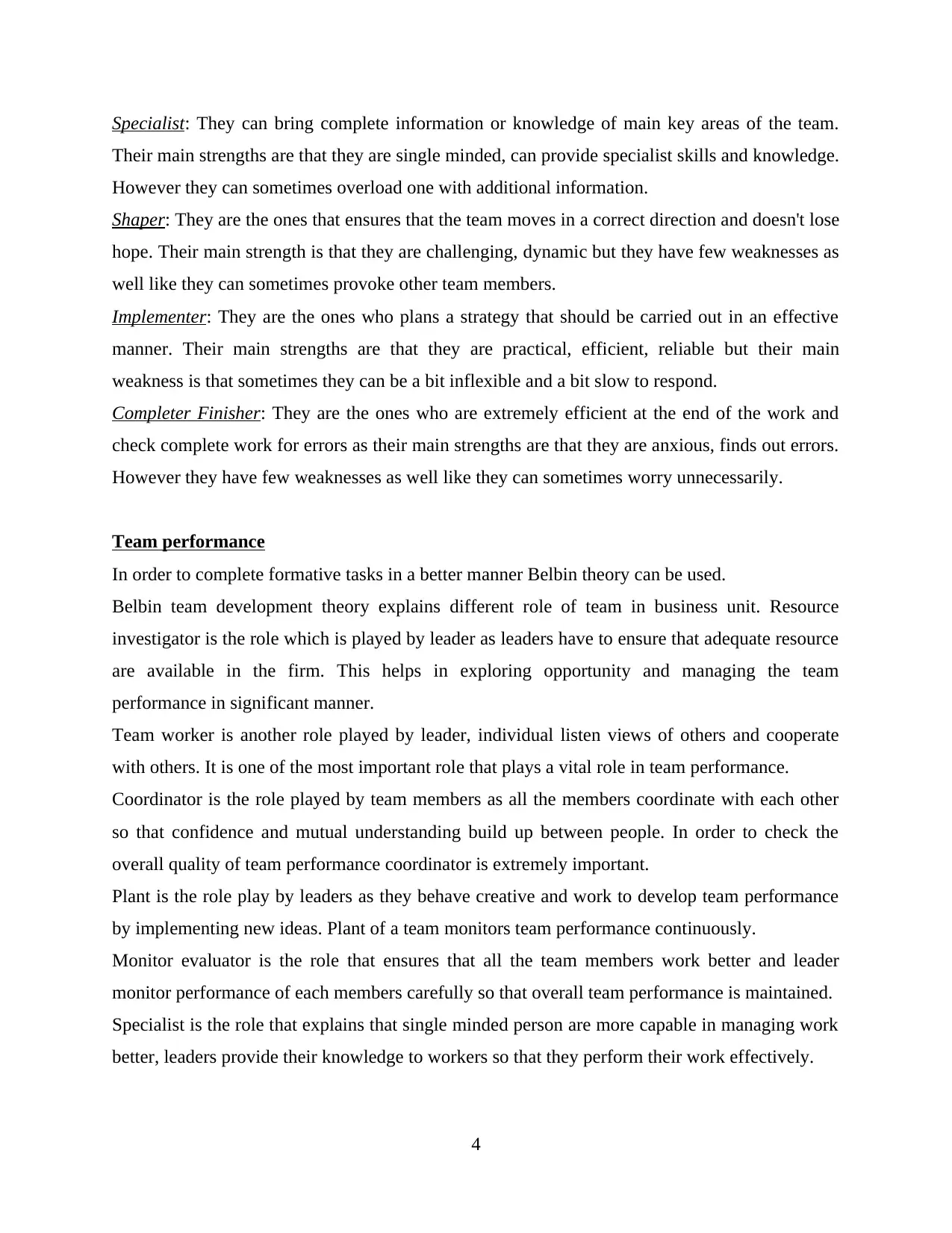
Specialist: They can bring complete information or knowledge of main key areas of the team.
Their main strengths are that they are single minded, can provide specialist skills and knowledge.
However they can sometimes overload one with additional information.
Shaper: They are the ones that ensures that the team moves in a correct direction and doesn't lose
hope. Their main strength is that they are challenging, dynamic but they have few weaknesses as
well like they can sometimes provoke other team members.
Implementer: They are the ones who plans a strategy that should be carried out in an effective
manner. Their main strengths are that they are practical, efficient, reliable but their main
weakness is that sometimes they can be a bit inflexible and a bit slow to respond.
Completer Finisher: They are the ones who are extremely efficient at the end of the work and
check complete work for errors as their main strengths are that they are anxious, finds out errors.
However they have few weaknesses as well like they can sometimes worry unnecessarily.
Team performance
In order to complete formative tasks in a better manner Belbin theory can be used.
Belbin team development theory explains different role of team in business unit. Resource
investigator is the role which is played by leader as leaders have to ensure that adequate resource
are available in the firm. This helps in exploring opportunity and managing the team
performance in significant manner.
Team worker is another role played by leader, individual listen views of others and cooperate
with others. It is one of the most important role that plays a vital role in team performance.
Coordinator is the role played by team members as all the members coordinate with each other
so that confidence and mutual understanding build up between people. In order to check the
overall quality of team performance coordinator is extremely important.
Plant is the role play by leaders as they behave creative and work to develop team performance
by implementing new ideas. Plant of a team monitors team performance continuously.
Monitor evaluator is the role that ensures that all the team members work better and leader
monitor performance of each members carefully so that overall team performance is maintained.
Specialist is the role that explains that single minded person are more capable in managing work
better, leaders provide their knowledge to workers so that they perform their work effectively.
4
Their main strengths are that they are single minded, can provide specialist skills and knowledge.
However they can sometimes overload one with additional information.
Shaper: They are the ones that ensures that the team moves in a correct direction and doesn't lose
hope. Their main strength is that they are challenging, dynamic but they have few weaknesses as
well like they can sometimes provoke other team members.
Implementer: They are the ones who plans a strategy that should be carried out in an effective
manner. Their main strengths are that they are practical, efficient, reliable but their main
weakness is that sometimes they can be a bit inflexible and a bit slow to respond.
Completer Finisher: They are the ones who are extremely efficient at the end of the work and
check complete work for errors as their main strengths are that they are anxious, finds out errors.
However they have few weaknesses as well like they can sometimes worry unnecessarily.
Team performance
In order to complete formative tasks in a better manner Belbin theory can be used.
Belbin team development theory explains different role of team in business unit. Resource
investigator is the role which is played by leader as leaders have to ensure that adequate resource
are available in the firm. This helps in exploring opportunity and managing the team
performance in significant manner.
Team worker is another role played by leader, individual listen views of others and cooperate
with others. It is one of the most important role that plays a vital role in team performance.
Coordinator is the role played by team members as all the members coordinate with each other
so that confidence and mutual understanding build up between people. In order to check the
overall quality of team performance coordinator is extremely important.
Plant is the role play by leaders as they behave creative and work to develop team performance
by implementing new ideas. Plant of a team monitors team performance continuously.
Monitor evaluator is the role that ensures that all the team members work better and leader
monitor performance of each members carefully so that overall team performance is maintained.
Specialist is the role that explains that single minded person are more capable in managing work
better, leaders provide their knowledge to workers so that they perform their work effectively.
4
⊘ This is a preview!⊘
Do you want full access?
Subscribe today to unlock all pages.

Trusted by 1+ million students worldwide
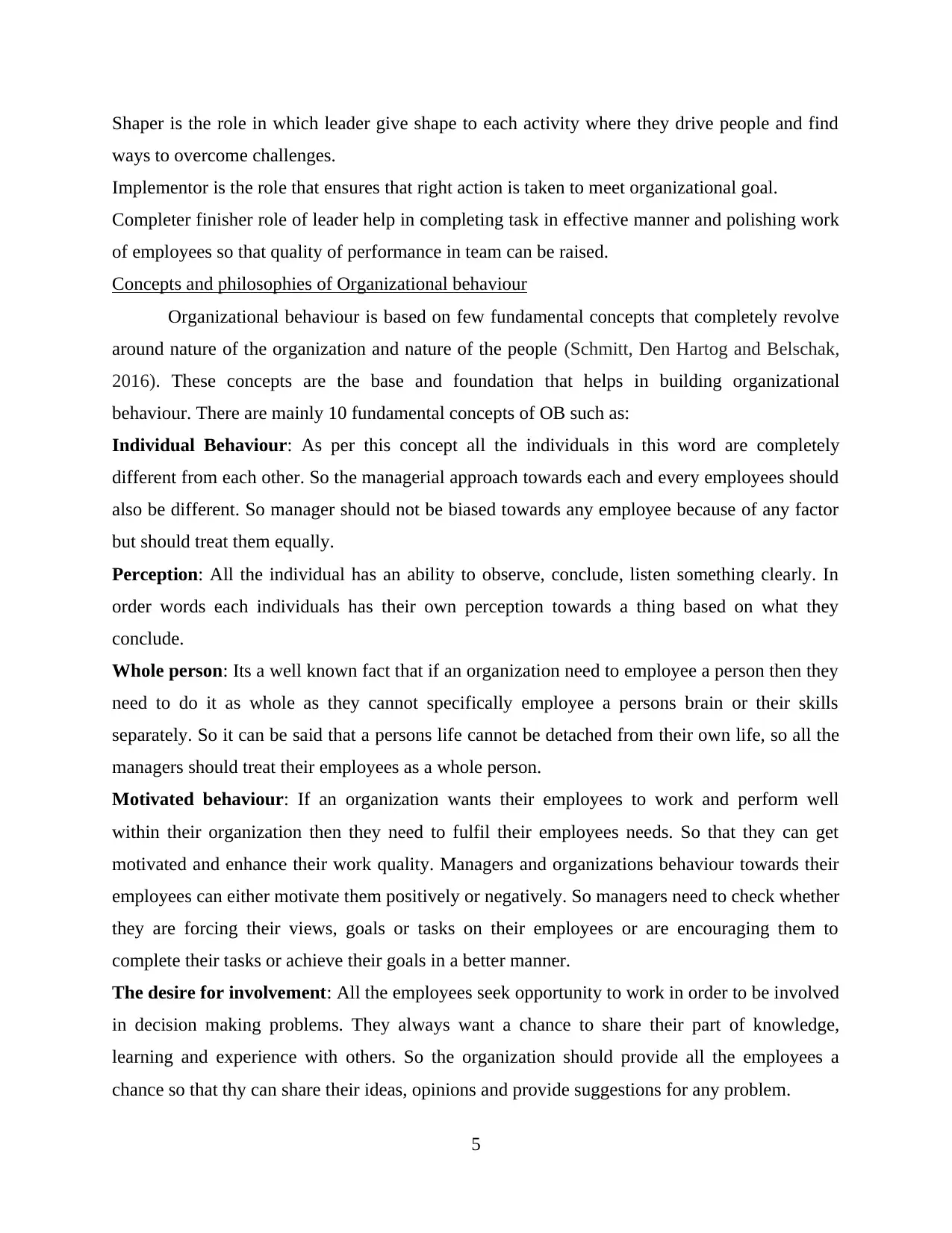
Shaper is the role in which leader give shape to each activity where they drive people and find
ways to overcome challenges.
Implementor is the role that ensures that right action is taken to meet organizational goal.
Completer finisher role of leader help in completing task in effective manner and polishing work
of employees so that quality of performance in team can be raised.
Concepts and philosophies of Organizational behaviour
Organizational behaviour is based on few fundamental concepts that completely revolve
around nature of the organization and nature of the people (Schmitt, Den Hartog and Belschak,
2016). These concepts are the base and foundation that helps in building organizational
behaviour. There are mainly 10 fundamental concepts of OB such as:
Individual Behaviour: As per this concept all the individuals in this word are completely
different from each other. So the managerial approach towards each and every employees should
also be different. So manager should not be biased towards any employee because of any factor
but should treat them equally.
Perception: All the individual has an ability to observe, conclude, listen something clearly. In
order words each individuals has their own perception towards a thing based on what they
conclude.
Whole person: Its a well known fact that if an organization need to employee a person then they
need to do it as whole as they cannot specifically employee a persons brain or their skills
separately. So it can be said that a persons life cannot be detached from their own life, so all the
managers should treat their employees as a whole person.
Motivated behaviour: If an organization wants their employees to work and perform well
within their organization then they need to fulfil their employees needs. So that they can get
motivated and enhance their work quality. Managers and organizations behaviour towards their
employees can either motivate them positively or negatively. So managers need to check whether
they are forcing their views, goals or tasks on their employees or are encouraging them to
complete their tasks or achieve their goals in a better manner.
The desire for involvement: All the employees seek opportunity to work in order to be involved
in decision making problems. They always want a chance to share their part of knowledge,
learning and experience with others. So the organization should provide all the employees a
chance so that thy can share their ideas, opinions and provide suggestions for any problem.
5
ways to overcome challenges.
Implementor is the role that ensures that right action is taken to meet organizational goal.
Completer finisher role of leader help in completing task in effective manner and polishing work
of employees so that quality of performance in team can be raised.
Concepts and philosophies of Organizational behaviour
Organizational behaviour is based on few fundamental concepts that completely revolve
around nature of the organization and nature of the people (Schmitt, Den Hartog and Belschak,
2016). These concepts are the base and foundation that helps in building organizational
behaviour. There are mainly 10 fundamental concepts of OB such as:
Individual Behaviour: As per this concept all the individuals in this word are completely
different from each other. So the managerial approach towards each and every employees should
also be different. So manager should not be biased towards any employee because of any factor
but should treat them equally.
Perception: All the individual has an ability to observe, conclude, listen something clearly. In
order words each individuals has their own perception towards a thing based on what they
conclude.
Whole person: Its a well known fact that if an organization need to employee a person then they
need to do it as whole as they cannot specifically employee a persons brain or their skills
separately. So it can be said that a persons life cannot be detached from their own life, so all the
managers should treat their employees as a whole person.
Motivated behaviour: If an organization wants their employees to work and perform well
within their organization then they need to fulfil their employees needs. So that they can get
motivated and enhance their work quality. Managers and organizations behaviour towards their
employees can either motivate them positively or negatively. So managers need to check whether
they are forcing their views, goals or tasks on their employees or are encouraging them to
complete their tasks or achieve their goals in a better manner.
The desire for involvement: All the employees seek opportunity to work in order to be involved
in decision making problems. They always want a chance to share their part of knowledge,
learning and experience with others. So the organization should provide all the employees a
chance so that thy can share their ideas, opinions and provide suggestions for any problem.
5
Paraphrase This Document
Need a fresh take? Get an instant paraphrase of this document with our AI Paraphraser
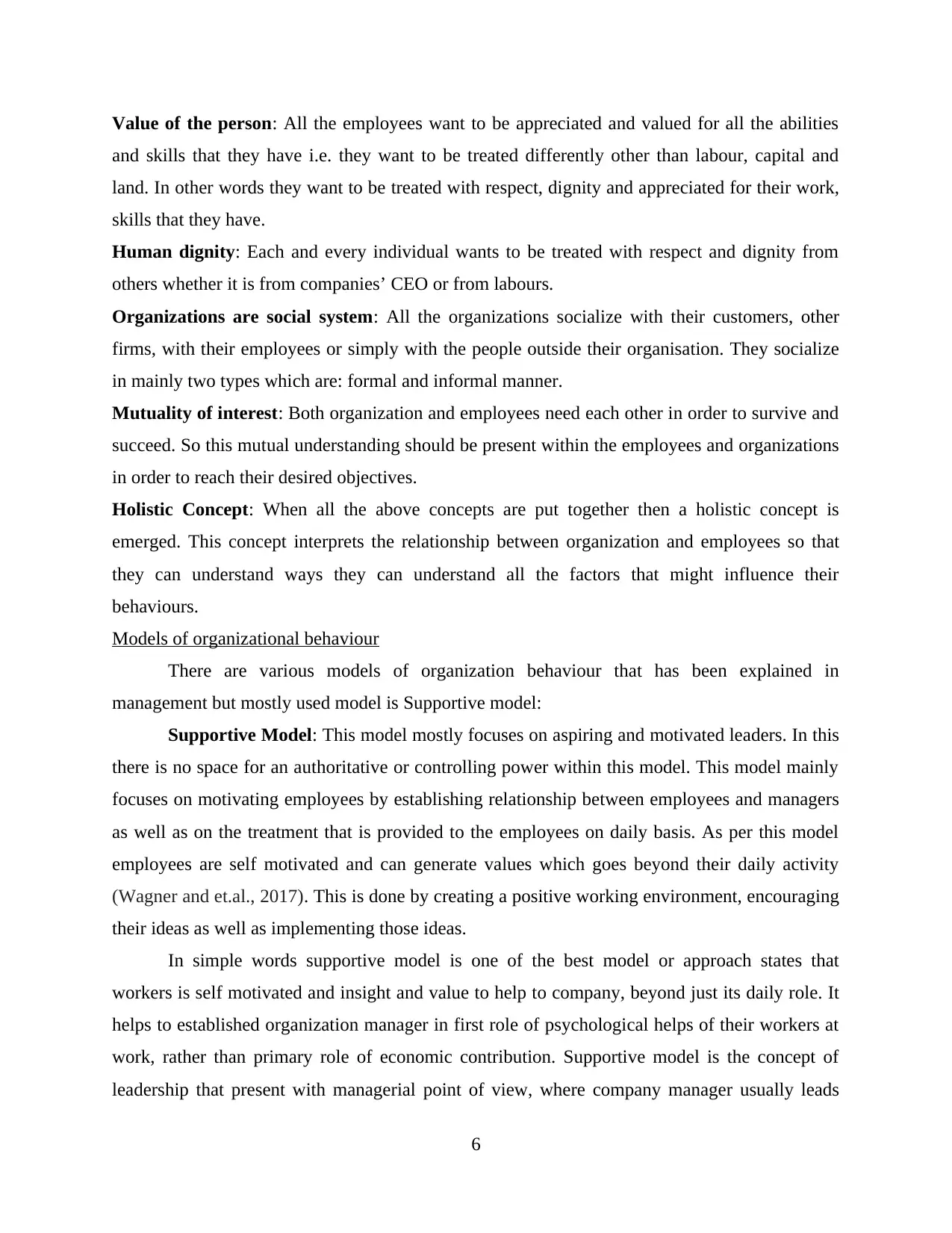
Value of the person: All the employees want to be appreciated and valued for all the abilities
and skills that they have i.e. they want to be treated differently other than labour, capital and
land. In other words they want to be treated with respect, dignity and appreciated for their work,
skills that they have.
Human dignity: Each and every individual wants to be treated with respect and dignity from
others whether it is from companies’ CEO or from labours.
Organizations are social system: All the organizations socialize with their customers, other
firms, with their employees or simply with the people outside their organisation. They socialize
in mainly two types which are: formal and informal manner.
Mutuality of interest: Both organization and employees need each other in order to survive and
succeed. So this mutual understanding should be present within the employees and organizations
in order to reach their desired objectives.
Holistic Concept: When all the above concepts are put together then a holistic concept is
emerged. This concept interprets the relationship between organization and employees so that
they can understand ways they can understand all the factors that might influence their
behaviours.
Models of organizational behaviour
There are various models of organization behaviour that has been explained in
management but mostly used model is Supportive model:
Supportive Model: This model mostly focuses on aspiring and motivated leaders. In this
there is no space for an authoritative or controlling power within this model. This model mainly
focuses on motivating employees by establishing relationship between employees and managers
as well as on the treatment that is provided to the employees on daily basis. As per this model
employees are self motivated and can generate values which goes beyond their daily activity
(Wagner and et.al., 2017). This is done by creating a positive working environment, encouraging
their ideas as well as implementing those ideas.
In simple words supportive model is one of the best model or approach states that
workers is self motivated and insight and value to help to company, beyond just its daily role. It
helps to established organization manager in first role of psychological helps of their workers at
work, rather than primary role of economic contribution. Supportive model is the concept of
leadership that present with managerial point of view, where company manager usually leads
6
and skills that they have i.e. they want to be treated differently other than labour, capital and
land. In other words they want to be treated with respect, dignity and appreciated for their work,
skills that they have.
Human dignity: Each and every individual wants to be treated with respect and dignity from
others whether it is from companies’ CEO or from labours.
Organizations are social system: All the organizations socialize with their customers, other
firms, with their employees or simply with the people outside their organisation. They socialize
in mainly two types which are: formal and informal manner.
Mutuality of interest: Both organization and employees need each other in order to survive and
succeed. So this mutual understanding should be present within the employees and organizations
in order to reach their desired objectives.
Holistic Concept: When all the above concepts are put together then a holistic concept is
emerged. This concept interprets the relationship between organization and employees so that
they can understand ways they can understand all the factors that might influence their
behaviours.
Models of organizational behaviour
There are various models of organization behaviour that has been explained in
management but mostly used model is Supportive model:
Supportive Model: This model mostly focuses on aspiring and motivated leaders. In this
there is no space for an authoritative or controlling power within this model. This model mainly
focuses on motivating employees by establishing relationship between employees and managers
as well as on the treatment that is provided to the employees on daily basis. As per this model
employees are self motivated and can generate values which goes beyond their daily activity
(Wagner and et.al., 2017). This is done by creating a positive working environment, encouraging
their ideas as well as implementing those ideas.
In simple words supportive model is one of the best model or approach states that
workers is self motivated and insight and value to help to company, beyond just its daily role. It
helps to established organization manager in first role of psychological helps of their workers at
work, rather than primary role of economic contribution. Supportive model is the concept of
leadership that present with managerial point of view, where company manager usually leads
6
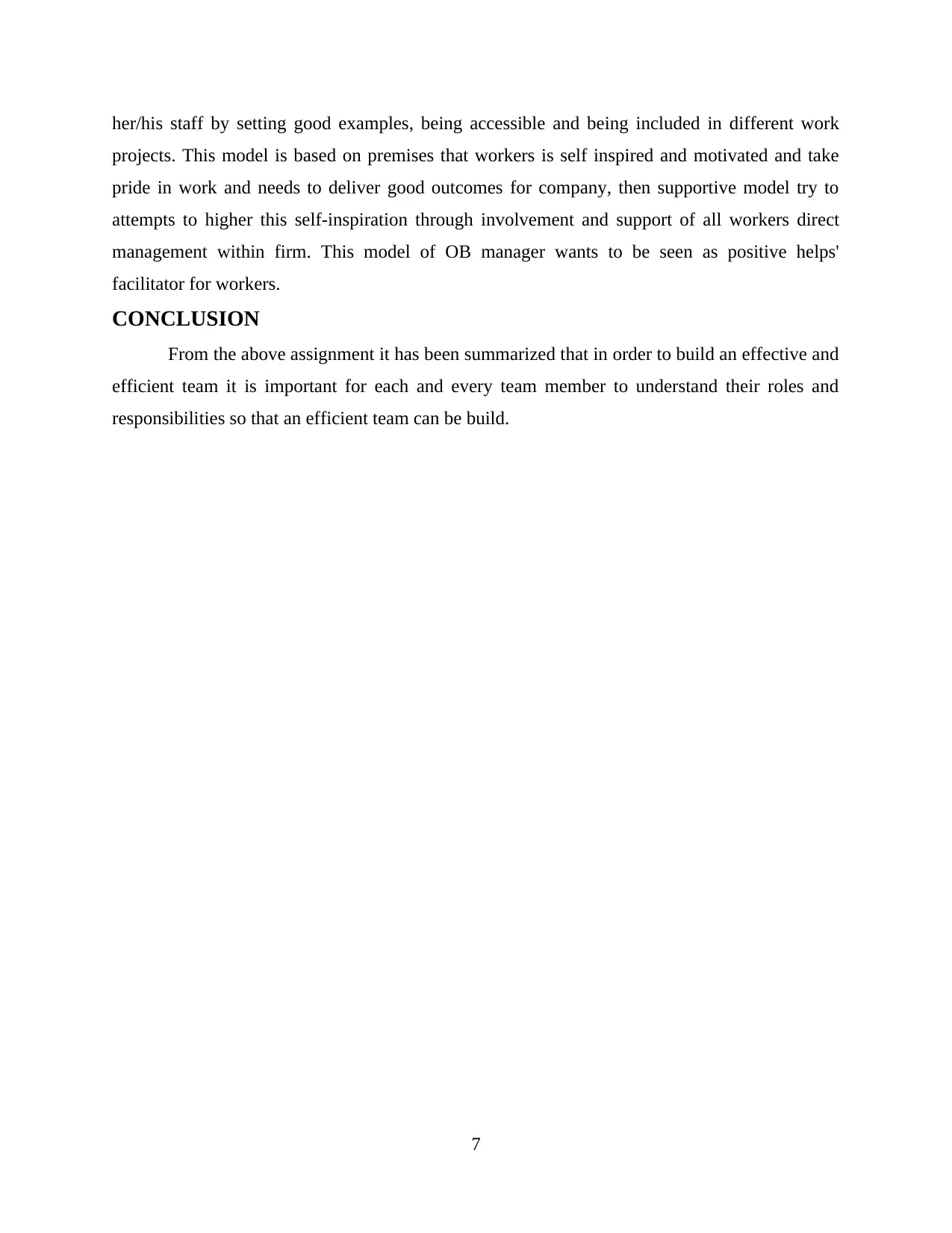
her/his staff by setting good examples, being accessible and being included in different work
projects. This model is based on premises that workers is self inspired and motivated and take
pride in work and needs to deliver good outcomes for company, then supportive model try to
attempts to higher this self-inspiration through involvement and support of all workers direct
management within firm. This model of OB manager wants to be seen as positive helps'
facilitator for workers.
CONCLUSION
From the above assignment it has been summarized that in order to build an effective and
efficient team it is important for each and every team member to understand their roles and
responsibilities so that an efficient team can be build.
7
projects. This model is based on premises that workers is self inspired and motivated and take
pride in work and needs to deliver good outcomes for company, then supportive model try to
attempts to higher this self-inspiration through involvement and support of all workers direct
management within firm. This model of OB manager wants to be seen as positive helps'
facilitator for workers.
CONCLUSION
From the above assignment it has been summarized that in order to build an effective and
efficient team it is important for each and every team member to understand their roles and
responsibilities so that an efficient team can be build.
7
⊘ This is a preview!⊘
Do you want full access?
Subscribe today to unlock all pages.

Trusted by 1+ million students worldwide
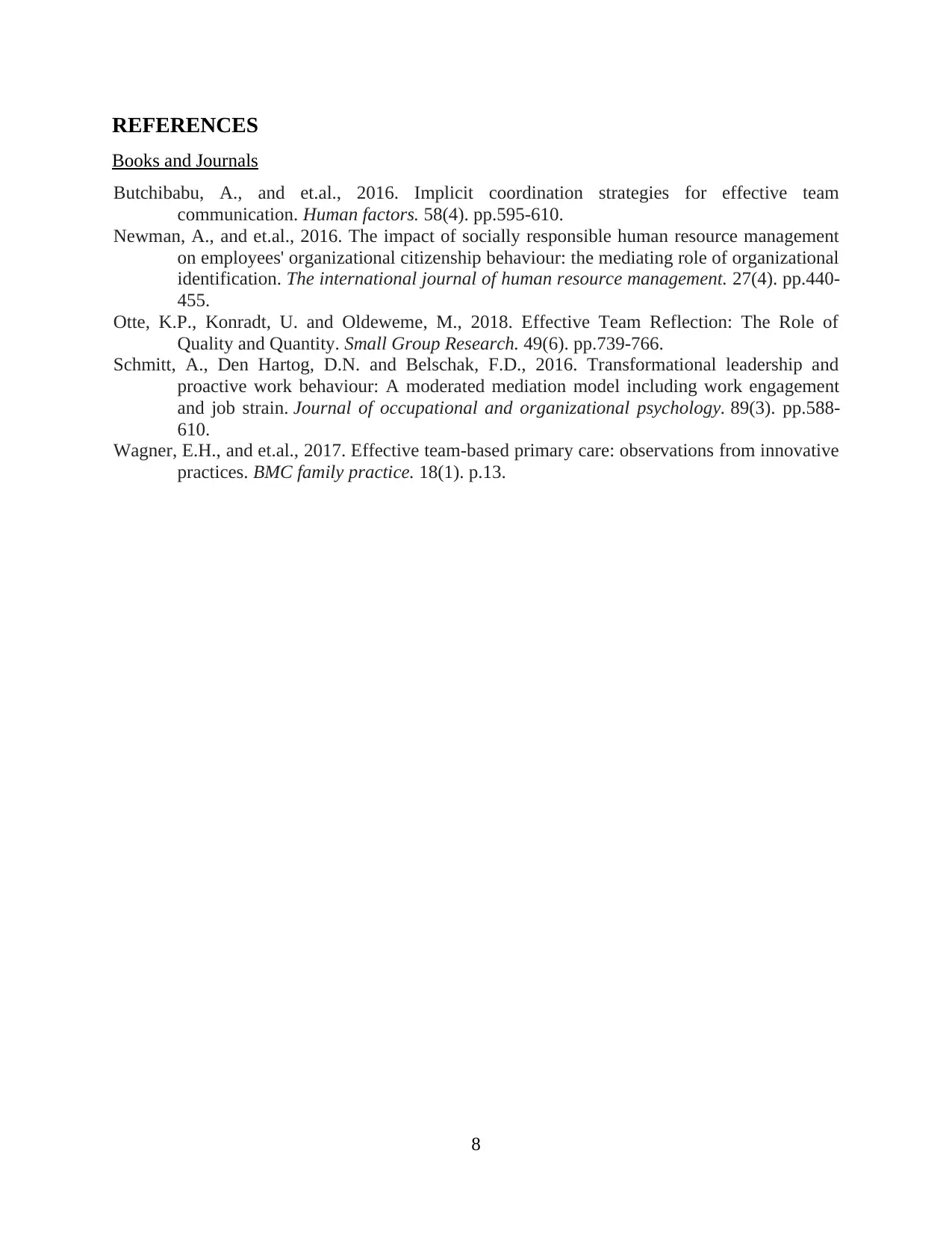
REFERENCES
Books and Journals
Butchibabu, A., and et.al., 2016. Implicit coordination strategies for effective team
communication. Human factors. 58(4). pp.595-610.
Newman, A., and et.al., 2016. The impact of socially responsible human resource management
on employees' organizational citizenship behaviour: the mediating role of organizational
identification. The international journal of human resource management. 27(4). pp.440-
455.
Otte, K.P., Konradt, U. and Oldeweme, M., 2018. Effective Team Reflection: The Role of
Quality and Quantity. Small Group Research. 49(6). pp.739-766.
Schmitt, A., Den Hartog, D.N. and Belschak, F.D., 2016. Transformational leadership and
proactive work behaviour: A moderated mediation model including work engagement
and job strain. Journal of occupational and organizational psychology. 89(3). pp.588-
610.
Wagner, E.H., and et.al., 2017. Effective team-based primary care: observations from innovative
practices. BMC family practice. 18(1). p.13.
8
Books and Journals
Butchibabu, A., and et.al., 2016. Implicit coordination strategies for effective team
communication. Human factors. 58(4). pp.595-610.
Newman, A., and et.al., 2016. The impact of socially responsible human resource management
on employees' organizational citizenship behaviour: the mediating role of organizational
identification. The international journal of human resource management. 27(4). pp.440-
455.
Otte, K.P., Konradt, U. and Oldeweme, M., 2018. Effective Team Reflection: The Role of
Quality and Quantity. Small Group Research. 49(6). pp.739-766.
Schmitt, A., Den Hartog, D.N. and Belschak, F.D., 2016. Transformational leadership and
proactive work behaviour: A moderated mediation model including work engagement
and job strain. Journal of occupational and organizational psychology. 89(3). pp.588-
610.
Wagner, E.H., and et.al., 2017. Effective team-based primary care: observations from innovative
practices. BMC family practice. 18(1). p.13.
8
1 out of 10
Related Documents
Your All-in-One AI-Powered Toolkit for Academic Success.
+13062052269
info@desklib.com
Available 24*7 on WhatsApp / Email
![[object Object]](/_next/static/media/star-bottom.7253800d.svg)
Unlock your academic potential
Copyright © 2020–2025 A2Z Services. All Rights Reserved. Developed and managed by ZUCOL.





